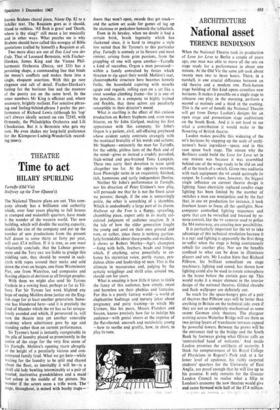National asset
ARCHITECTURE TERENCE BENDIXSON
When the National Theatre took its production of Love for Love to Berlin a couple of years ago, one man was able to move all the sets on stage ready for a performance in about one minute. At the Old Vic the same job took about twenty men two to three hours. There, in a nutshell, is one crucial difference between an old theatre and a modern one. Push-button stage building of this kind opens countless new horizons. It makes it possible on a single stage to rehearse one play in the morning, perform a second at matinie and a third in the evening. This is the sort of benefit the National Theatre will get from Denys Lasdun's designs for an • open stage and proscenium stage auditorium on the South Bank. And it is not hard to see what a contribution it would make to the flowering of British theatre.
Lasdun makes possible this widening of the tar's horizons by stepping up the scale of archi- tecture's basic ingredient—space, and in this case space back stage. The reason why the Berliners could build the Love for Love set in one minute was because it was assembled behind one of the wings ready to be slid on and off at the touch of a switch. Given two auditoria with such equipment the NT could quintuple its output. In Lasdun's view, however, the biggest single influence on current theatre design is lighting. Since electricity replaced candles stage lighting has been limited by the number of switches a man can manipulate and by the fact that, in one NT production for instance, it took fourteen hours to focus all the spotlights. Now computer controlled lighting sequences and spots that can be swivelled and focused by re- mote control, like the TV cameras used to police the M4 motorway, are creating new possibilities.
It is particularly important for the NT to take advantage of this technical revolution because it is a rep; and lighting is apparently the first thing to. suffer when the stage is being continuously rebuilt for another play. Nor are the benefits confined to what can be done to illuminate players and sets. Mr Lasdun hints that Richard Pilbrow, his brilliant consultant on stage machinery, lighting and sound, has shown how lighting could also be used to create atmosphere in the house before the curtain goes up. This would make it a major element in the interior design of the national theatres. Gilded cherubs and flock wallpaper are definitely out.
So much for the space-hungry guts of a pair of theatres that Pilbrow says will be better than anything in Britain on the technical side, even if they are not so completely mechanised as some recent German civic theatres. The playgoer arriving across Waterloo Bridge will see them as two jutting layers of translucent terraces capped by.powerful towers. Between the prows will be the entrances tied to the bridge and the South Bank by footways giving what Olivier calls an 'outstretched hand of welcome.' And inside Lasdun promises the antithesis of austerity. I think the sumptuousness of his Royal College of Physicians in Regent's Park and, at a far lower level of opulence, his richly carpeted students'--quarters for the University of East Anglia, are proof enough that he will live up to his promise. It only remains for the Greater London Council to realise what a fillip to London's economy the new theatres would give and come forward with half of the £7.4 million.


































 Previous page
Previous page